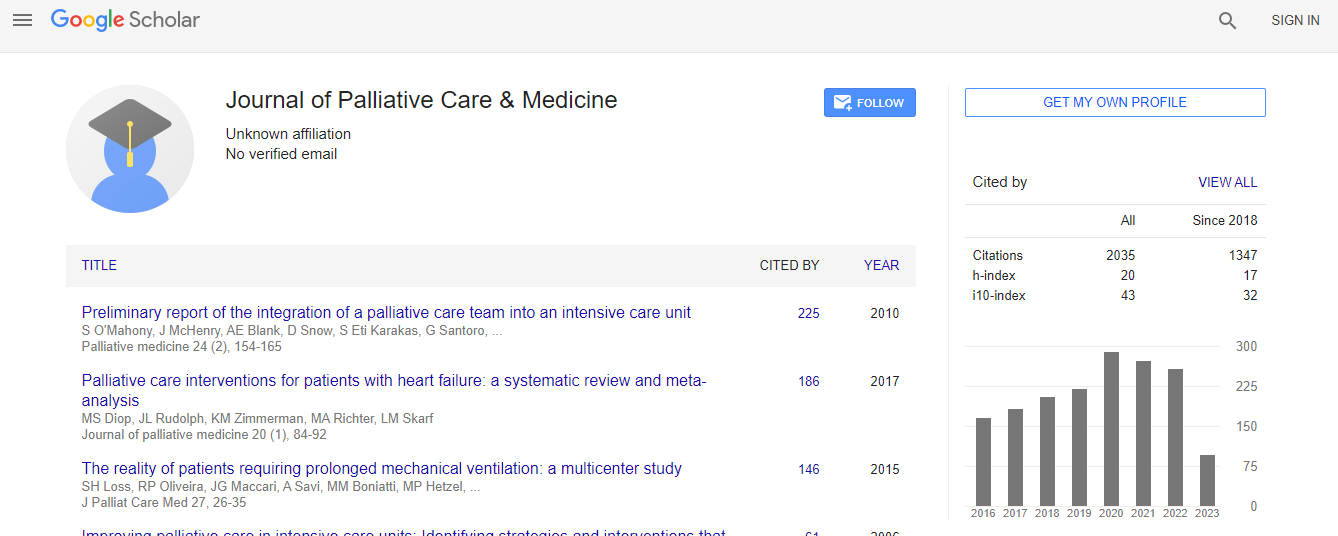Our Group organises 3000+ Global Conferenceseries Events every year across USA, Europe & Asia with support from 1000 more scientific Societies and Publishes 700+ Open Access Journals which contains over 50000 eminent personalities, reputed scientists as editorial board members.
Open Access Journals gaining more Readers and Citations
700 Journals and 15,000,000 Readers Each Journal is getting 25,000+ Readers
Recommended Conferences
42nd Global Conference on Nursing Care & Patient Safety
Toronto, CanadaGoogle Scholar citation report
Citations : 2035
Journal of Palliative Care & Medicine received 2035 citations as per Google Scholar report
Journal of Palliative Care & Medicine peer review process verified at publons
Indexed In
- Index Copernicus
- Google Scholar
- Open J Gate
- Genamics JournalSeek
- China National Knowledge Infrastructure (CNKI)
- Electronic Journals Library
- RefSeek
- Hamdard University
- EBSCO A-Z
- OCLC- WorldCat
- Virtual Library of Biology (vifabio)
- Publons
- Geneva Foundation for Medical Education and Research
- Euro Pub
- ICMJE
Useful Links
Recommended Journals
Related Subjects
Share This Page
THE IMPACT OF PERSON-CENTERED CARE ON OLDER PEOPLES PERCEPTIONS OF CARE QUALITY IN NURSING HOMES: AN INTERVENTION STUDY
7th International Conference on Geriatrics Gerontology & Palliative Nursing
Liv Berit Fagerli
├?┬?stfold University College, Norway
ScientificTracks Abstracts: J Palliat Care Med
Abstract
Statement of the Problem: The quality of care offered to older people in nursing homes varies. Nursing home administrators often claim that they provide person-centered care, but research indicates that institutional goals take precedence. Personcentered care may influence the older people├ó┬?┬?s quality of life. The purpose of this study was to explore the impact of personcentered care on older people├ó┬?┬?s perceptions of care quality. Methodology & Theoretical Orientation: In our study, person-centered care was operationalized into one intervention: oneto- one contact (resident ├ó┬?┬? carer). The intervention was systematically conducted for 12 months in one nursing home (41 residents). One of the carers should spend 30 minutes twice a week alone with one resident. This form of companionship comprised activities such as talking, watching TV and going for a walk. Face-to-face interviews using the Quality from Patient├ó┬?┬?s Perspective (QPP) questionnaire were conducted both prior to intervention and immediately after the 12-month period. The questionnaire comprises of four dimensions: caregivers├ó┬?┬? medical-technical competence and identity-oriented approach, and care organisation├ó┬?┬?s socio-cultural approach and physical-technical conditions. Descriptive and comparative statistics were used to test for differences between care quality perceptions before and after intervention (p<.05). Results: The older people rated all four quality dimensions significantly higher after the 12-month period. At the item level significantly higher scores were given to ├ó┬?┬?The healthcare personnel showed commitment├ó┬?┬?, ├ó┬?┬?The healthcare personnel were respectful towards me├ó┬?┬?,├ó┬?┬?I received the best possible medical care├ó┬?┬? and ├ó┬?┬?There was a pleasant atmosphere on the ward├ó┬?┬?. Conclusion & Significance: Older people├ó┬?┬?s perceptions of care quality increase when person-centered care is operationalized and takes precedence over ward routines. The results indicate that it is possible to design a care system where the older people are at the center of the health care offered.Biography
Liv Berit Fagerli has worked as a teacher and researcher at Østfold University College in Norway since 1993. Her experiences and interests, concerns community health and person centered care, both in teaching and research. From 2013-2016 she has done research together with other researchers at the University College, on older people’s perceptions of care quality in nursing homes with special attention to person centered care. She has contributed in an intervention study that indicates that it is possible to design a care system where the older people are at the center of the health care offered.

 Spanish
Spanish  Chinese
Chinese  Russian
Russian  German
German  French
French  Japanese
Japanese  Portuguese
Portuguese  Hindi
Hindi 
